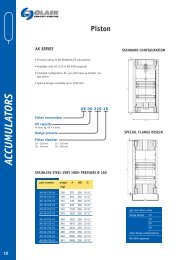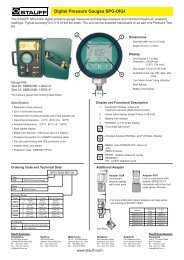Local Solutions for Individual Customers Worldwide - Oil Solutions
Local Solutions for Individual Customers Worldwide - Oil Solutions
Local Solutions for Individual Customers Worldwide - Oil Solutions
Create successful ePaper yourself
Turn your PDF publications into a flip-book with our unique Google optimized e-Paper software.
Precharging Procedure<br />
General In<strong>for</strong>mation<br />
14<br />
Accumulators and Accessories<br />
• Prior to commissioning a hydraulic system, any accumulators in the system should have their pre-charge<br />
pressure checked and adjusted.<br />
• The condition of the accumulator is primarily determined by periodic checking of the pre-charge pressure.<br />
• Hydraulic Accumulators are pressure vessels and only qualifi ed personnel should per<strong>for</strong>m maintenance.<br />
• Drain all fl uid completely from accumulator be<strong>for</strong>e per<strong>for</strong>ming any maintenance.<br />
• DO NOT weld or braze directly on accumulator shell.<br />
• DO NOT use automotive type valve cores as high pressure accumulator gas valves.<br />
• The most accurate pre-charge readings can only be taken when fl uid pressure is at zero.<br />
• Always observe the maximum working pressure and operating temperature ranges.<br />
Pre-charging Bladder Accumulators<br />
A Isolate the accumulator from the system, open the drain valve and make sure hydraulic fl uid pressure is zero.<br />
B Remove gas valve protection cap and valve cap from the accumulator.<br />
C To charge the accumulator, use a charging hose and gauge assembly from the Stauff Charging Kit # STA-CK-1<br />
rated <strong>for</strong> 250 bar maximum.<br />
D Be<strong>for</strong>e using the charging assembly (Figure 1.) make sure that valve A is completely open (counter-clockwise),<br />
and that bleed valve B (Figure 1.) is closed.<br />
E Connect the charging unit to the gas fi ll valve on the accumulator by means of knurled cap D (Figure 1.).<br />
F Fit the gas bottle adaptor (included in Stauff charging kit) to the nitrogen bottle, make sure that the gas valve on<br />
the nitrogen bottle is closed (see Figure 2.) then attach gas hose to the gas bottle adaptor on the nitrogen bottle.<br />
G Connect the other end of gas hose to the Stauff test coupling C (Figure 1.), after taking off its cap.<br />
H Turn valve A (Figure 1.) clockwise to the point where resistance is felt or pressure is registered on the<br />
gauge(only if there is an existing pre-charge).<br />
I SLOWLY open valve on nitrogen bottle (Figure 2.) and allow the gas to fl ow to the accumulator.<br />
J When the pressure in the accumulator is slightly higher than is required, close the valve on the nitrogen bottle.<br />
K Open valve A (Figure 1.) (counter-clockwise) and reduce the pressure in the gas hose and charging assembly to<br />
zero by means of bleed valve B (Figure 1.).<br />
L Remove hose from non-return Stauff test coupling C (Figure 1.) and replace cap.<br />
M Close the bleed valve B (Figure 1.) and wait a few minutes <strong>for</strong> pressure to stabilise.<br />
N Screw valve A (Figure 1.) clockwise until pressure can be read on gauge. This should be slightly higher than the<br />
required pressure.<br />
O Adjust pressure by means of bleed valve B (Figure 1.), then unscrew valve A (Figure 1.), counterclockwise.<br />
Open valve B (fi gure 1) then remove charging unit.<br />
P Replace gas valve cap and protective cap on accumulator. Accumulator is now ready <strong>for</strong> use.<br />
B<br />
A<br />
D<br />
C<br />
- Safety pattern gauge.<br />
Figure 1 Figure 2<br />
NOTE: Allow accumulator to rest about 10-15 minutes after gas pre-charging. This will allow gas temperature to adjust<br />
and equalize. Recheck gas pre-charge pressure and adjust if necessary. Check accumulator gas valve <strong>for</strong> any leaks<br />
with soapy water. Always wear safety glasses.





